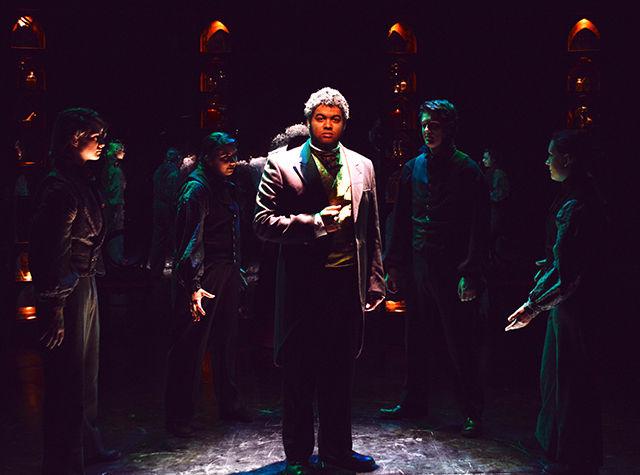 " />
" />
Kaydee Gawlik
Nicholas Peaks, a senior studying science education (center), plays Dr. Henry Jekyll, surrounded by the four versions of Edward Hyde: Louis Bailey, a sophomore studying industrial design; Raven Stone, a sophomore studying anthropology; Matthew Tucker, a senior studying communication; and Sydney Smallwood, a freshman studying anthropology. University Theatre presents "Dr. Jekyll and Mr. Hyde," adapted by Jeffrey Hatcher from the novella "Strange Case of Dr. Jekyll and Mr. Hyde" by Robert Louis Stevenson. Dr. Jekyll and Mr. Hyde opened Thursday at 7:30 p.m. in Titmus Theatre and runs until Sunday at 2 p.m. The crew includes Jayme Mellema, Joshua Reaves, Laura Parker and Mia Self who designed the set, light and sound and costumes, respectively. Self directed the play.
Perceptions of rage, internal conflict and personal image were on full display Thursday at Titmus Theatre as University Theatre performed “Dr. Jekyll and Mr. Hyde,” a theatrical adaptation of the Victorian-age novella by Robert Louis Stevenson. Performances continued Friday and Saturday and will end next Sunday.
The play is about a man named Dr. Henry Jekyll, who experiments with potions and powders to explore what he calls the differences between the brain and the mind.
“It’s a fun little experiment on the nature of man,” said Matthew Tucker, a senior studying communication and the actor who plays Edward Hyde #3. “It’s just a man going against the darker aspect of his personality. It’s coming out, it’s taking control and he’s trying to suppress it.”
Throughout the performance, Jekyll wrestles with his urges, attempting to maintain his reputation of stature. This becomes complicated when he has ties with Edward Hyde, a man tainted with cruelty and violence.
“It’s a classic retelling of the story of good versus evil, man versus beast, dealing with all the internal struggles in the world, and the story of perception,” said Nico Peaks, a senior studying science education and the actor who plays Dr. Jekyll.
The play’s cast is somewhat unconventional, with four different actors playing Edward Hyde. These actors have other roles as well, changing characters at a moment’s notice.
“The most important part of this experience, for me, has just been all the character work that we’ve been doing,” Peaks said. “Each of us views things differently. You have the four characters who are each playing Hyde, but they’re also playing these other characters.”
Katie Owens, a sophomore studying biological sciences who was in attendance at Friday’s performance, found that having multiple Hydes contributed to the work.
“I was surprised by how many Hydes they had … but they made it work,” Owens said. “I would definitely recommend [the play]. I love how thought-provoking it was, and I love how they used music to integrate it into the suspense.”
In parts of the performance, the actors seem to be dancing. They move with a concentrated fluidity, all synchronized with one another. This motion is a key component of play, according to Mary Elizabeth Lennon, a senior studying English and the actress who plays Elizabeth Jelkes.
“It gave it a really conceptual feel,” Lennon said. “Otherwise, it could be a really stuffy Victorian show, and it just kind of added to the feeling of the bizarre [nature of the play].”
Because of the added challenge of choreography, the actors had to put in more physical work than is atypical of other University Theatre performances.
“We did several movement and acrobatic rehearsals first,” Lennon said. “A lot of the leaning and kind of supporting each other’s weight. We did a lot of work that didn’t go into the actual production just to get used to each other’s bodies and move with each other, which is really tough but really rewarding.”
The choreography is also paired with modern music, contrasting against the play’s late-1800s setting.
“The modern music and the movement, and the sort of dance choreography … was very interesting,” said Kinzie Burke, a freshman studying design, who was in attendance at Friday’s performance.
Lennon sees the modern music as an aid for relating an older work to modern times.
“What [the music] really brings to [the play] is a sense of yes, it’s a classic novel, but these themes are timeless,” Lennon said. “Everyone experiences these urges to really give in to your primal self, so putting this modern music in it … really drives home the idea that this could be anybody. These characters could be found anywhere, which is pretty cool. Scary, but cool.”
In addition, the set conveys a sense of simplicity. Upon further inspection, however, the set is rather complex. The background never changes, instead being used to represent every location. The set’s doors and mirrors are utilized in inventive ways, which Peaks says reflect the play’s themes.
“We played up the theme of mirrors, projections, sleight of eye, illusions, those kinds of things,” Peaks said. “Everything is kind of centered around this theme of mirrors having this reflective, yet shattered feel to it.”
All in all, the play combines themes of suspense, morality and introspection to have audience members look back at themselves.
“Every character is, in an essence, kind of broken,” Peaks said. “You’re always trying to keep up this image, but it’s looking back at you. It makes you look at yourself. Is this how I think? Am I putting on this image to hold myself up in front of everyone else? Or do I give away to my desires and bestial instincts? We all have a bit of Jekyll in us, and we all have a bit of Hyde.”